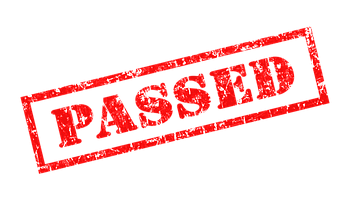
Knowing how to pass TOEFL test day is critical for international students who want to an attend English-speaking school. But what does “passing the TOEFL” really mean? Is there a certain TOEFL passing score everyone must get?
In truth, a TOEFL passing score is any score that’s high enough to get you into the schools you wish to attend. Therefore, the score you need to pass the TOEFL will vary depending on where you’re applying.
In this guide, we explain why you can’t technically pass (or fail) the TOEFL. We also give you tips on how to find your TOEFL passing score, how to increase your odds of passing the TOEFL, and what to do if you’re struggling to reach your passing score.
Can You Pass (or Fail) the TOEFL?
First things first, can you pass the TOEFL? The answer is, sort of. There are no hard-and-fast cutoffs for passing or failing the TOEFL. Most scores you get can be considered passing or failing scores depending on what your score goals are. (I say “most scores” and not “all scores” because most schools require TOEFL scores in at least the 70s. Any score below the 70s, then, could generally be considered a failing score.)
Ultimately, a TOEFL passing score is any score that meets the minimum score requirements for all of the schools you’re applying to. Likewise, a failing score is any score that doesn’t meet the minimum score requirements for your schools.
Here’s an example: let’s say I’m applying to Columbia University. Columbia requires a TOEFL iBT score of 100 for undergraduate admission. Thus, any TOEFL score under 100 is a failing score for me since I can’t get into Columbia with that kind of score. On the other hand, any score at 100 or higher is a passing score for me since it meets the minimum score requirements for Columbia.
But what if you’re applying to more than one school? In this case, you’ll need to find a TOEFL score that meets the requirements for all of your schools and not just one. This will be your TOEFL goal score.
By the way: we have built the world's best online TOEFL course. Get online practice (TPO-sytle!) and individual grading and feedback on Speaking and Writing.
To be fair, it's possible to get a good TOEFL score studying alone. But PrepScholar is the world's most effective TOEFL course if you are worried about the TOEFL and are struggling to improve your score.
Learn how you can improve your TOEFL score by 15 points today.
How to Set a TOEFL Goal Score
A TOEFL goal score is guaranteed to meet all of your schools’ minimum score requirements and is thus the one most likely to get you accepted to all of the schools you’re applying to. Here, we walk you through the steps needed to find your own passing score for TOEFL.
Step 1: Make a Chart
To organize the TOEFL score information you find, make a chart with all of the schools you’re applying to. Across the top, write “TOEFL Required?” “Minimum TOEFL Requirement,” and “Notes.”
Here’s an example:
| School | TOEFL Required? | Minimum TOEFL Requirement | Notes |
| Columbia | |||
| NYU | |||
| Penn State | |||
| Northeastern |

Step 2: Find TOEFL Score Information
Next, you’ll need to look for TOEFL score information for each of your schools. Get on Google and search “[School Name] TOEFL minimum score” or “[School Name] TOEFL requirements.”
Try to find links to your school’s official website. The pages you’re most likely to find TOEFL score information on are application materials pages, admission requirements pages, and FAQ pages. You can also use ctrl + F to search for keywords such as “TOEFL,” “English,” and “proficiency.”
Let’s return to my example above. While researching, I discover that Columbia and NYU both want TOEFL iBT scores of at least 100. Meanwhile, Penn State requires a minimum score of 80, and Northeastern requires 99.
Here’s what my chart looks like again, this time with my schools’ TOEFL score information filled out:
| School | TOEFL Required? | Minimum TOEFL Requirement | Notes |
| Columbia | Yes | 100 | |
| NYU | Yes | 100+ to be competitive | No minimum required score |
| Penn State | Yes | 80 | |
| Northeastern | Yes | 92 |
Step 3: Get Your Goal Score
Now, find the highest TOEFL score in your chart. This will be your TOEFL goal score—that is, your own personal TOEFL passing score. This is the score that gives you the highest chance of getting accepted to all of your schools.
In my example above, the highest TOEFL score in my chart is 100 (for NYU and Columbia). This means that I’ll need to score at least 100 to pass the TOEFL.
How to Pass TOEFL: 8 Essential Steps
As we’ve explained above, a passing score for TOEFL varies depending on the schools you’re applying to. But how can you ensure you’ll have a solid shot at hitting your goal score? Follow our eight steps below to raise your odds of passing the TOEFL.
Step 1: Get to Know the TOEFL Format
Knowing the TOEFL format is key to doing well on test day. Take some time to go over the basics of how the test is structured and what it tests as well as how it’s scored.
Here is an overview of the TOEFL test structure:
| Section | Order on Test | Time | # of Questions | Scoring |
| Reading | 1 | 60-80 mins* | 36-56 questions* | 0-30 |
| Listening | 2 | 60-90 mins* | 34-51 questions* | 0-30 |
| Speaking | 3 | 20 mins | 6 tasks | 0-30 |
| Writing | 4 | 50 mins | 2 tasks | 0-30 |
Source: ETS.org
*On Reading and Listening, you may come across extra experimental questions, which will increase your time and number of questions for that section.
You should also get to know each TOEFL section in detail. Learn what the Reading, Listening, Speaking, and Writing sections test to see what kind of content you’ll need to know for the exam.
Step 2: Find Your Baseline Score
To make a good TOEFL study plan and eventually pass the TOEFL, you must find your baseline score. A baseline score is the opposite of a goal score; it’s the score you start with before doing any TOEFL test prep.
The easiest way to find your baseline score is to take a full-length TOEFL practice test. Official tests are ideal because they have the most realistic practice questions and use a structure similar to the format of the test.
Unfortunately, official TOEFL tests aren’t free. Here’s what’s currently available to buy:
- Four TOEFL Practice Online (TPO) tests (coming soon) — 45.95 USD per test
- Two practice tests in The Official Guide to the TOEFL Test — about 25 USD
- Five practice tests in Official TOEFL iBT Tests Volume 1 — about 20-25 USD
- Five practice tests in Official TOEFL iBT Tests Volume 2 — about 20-25 USD
Make sure to recreate a realistic TOEFL testing environment: gather scratch paper, find a slightly noisy room (the testing room will likely get a little loud as test takers reach the Speaking section), and check that your headphones and microphone work properly before you begin.
Once you finish the test and have your scores for each section, write them down. Your total TOEFL score will be your baseline score.

Step 3: Calculate the Number of Hours You’ll Need to Study
Using your baseline and goal scores, you can now figure out roughly how many hours you’ll need to study in order to hit your TOEFL goal score.
Below are our estimates for the number of hours you’ll need to prep on each TOEFL section in order to make a 1-point improvement. Note that these are rough estimates—exact study hours will vary.
| Section | Study Hours for 1-Point Improvement |
| Reading | 6-8 |
| Listening | 6-8 |
| Speaking | 15* |
| Writing | 6-8 |
*Speaking usually takes about double the amount of prep time to make a 1-point improvement, so be sure to divide your time appropriately.
Want to improve your TOEFL score? We have the world's leading TOEFL course.
Built by world-class instructors from Harvard and MIT, the course offers individual review, interactive lessons, and realistic online praactice, at an affordable price! It's the fastest way to get your target TOEFL score.
Subtract your baseline score from your goal score. This will tell you how many total points you need to improve by. For example, if my baseline score were 92 and my goal score were 100, I’d need 8 points to hit my goal score.
Next, estimate the number of points you’ll need to improve by for each section. Because I need to improve my total TOEFL score by 8 points, I could aim to gain 2 points on each section. Thus, I’d need to study at least 66 total hours: 2(6) + 2(6) + 2(15) + 2(6) = 66.
In the end, you may divide up these points however you want. For instance, if I wanted to make a bigger improvement on my Reading score, I could instead aim to gain 3 points on that section and only 1 on Writing.
Step 4: Make a Study Plan
Now that you know how many (approximate) hours you’ll need to study for the TOEFL, it’s time to make a study plan.
How long you study for the TOEFL will depend mainly on your test date. Ideally, you’ll have three to six months of study time before your test. This should generally be enough time for you to fit in all of your study hours without issue.
Divide up your study hours so that you have a rough number of study hours for each week. For example, let’s say I need to study 66 total hours and have three months until my test date. This means I’ll need to study about five and a half hours per week to be able to hit my goal score.
Remember that you don’t have to study in one whole sitting each week; you may divide your time so that you’re studying a few hours on one day and a few on another. Ultimately, do what works best for you!
Step 5: Use High-Quality Resources to Learn Content and Practice
Once you begin studying for the TOEFL, use the best resources available to get the most out of your prep. You’ll primarily use these resources to study content, familiarize yourself with the format of the test, and practice what you’ve learned.
Always start with official TOEFL resources (i.e., those made by ETS), as these are by far your best bets for authentic TOEFL content and practice questions.
Fortunately, many official TOEFL materials are free. Here are the best ones you can use:
- TOEFL iBT Interactive Sampler: This downloadable software offers an abbreviated TOEFL test with questions for all sections and an interface nearly identical to what you’ll see on test day.
- TOEFL iBT Quick Prep: This four-volume collection of PDFs contains practice questions for all sections as well as MP3 files for audio clips.
- TOEFL iBT Sample Questions: This PDF is similar to Quick Prep but contains fewer practice questions overall.
You can also buy official materials. These include the following:
- The Official Guide to the TOEFL Test: This is the most comprehensive official TOEFL prep book on the market. For about 25 USD, you’ll get two full-length practice tests, hundreds of practice questions, and an array of helpful test-taking strategies.
- Official TOEFL iBT Tests Volumes 1 and 2: These two prep books cost around 20-25 USD each and offer a total of 10 full-length practice tests.
- TOEFL Practice Online (TPO) tests (coming soon): These online tests are real, retired TOEFLs and use the same interface and time limits as the real exam. The only downside is that these tests are pretty expensive at 45.95 USD a piece.
Finally, you can look for high-quality, unofficial TOEFL prep materials. Just make sure you’re using ones that are highly rated and contain realistic practice questions. Our guide to TOEFL prep books includes some of the best unofficial books for TOEFL prep. Additionally, check out our guide to TOEFL practice tests for tips on how to use your resources effectively.

Step 6: Master Key Strategies
In addition to learning content, you’ll need to practice both test-prep and test-taking strategies. Strategies teach you how to approach problems, manage your time, and stay confident; thus, knowing them will give you a better chance of hitting your TOEFL passing score on test day.
Here are some of the best TOEFL tips and strategies to use for each section:
Reading
- Memorize common TOEFL vocabulary words
- Choose a passage-reading strategy
- Use context clues in passages to figure out the meanings of unfamiliar words
- Take ample notes on the audio clips
- Pace yourself—spend about 20 minutes on each passage and question set
- Skip difficult questions and return to them later
- Use the process of elimination to narrow down your answers
Listening
- Listen to a variety of English accents, including North American, British, and Australian
- Take ample notes on the audio clips
- Use the process of elimination to narrow down your answers
- Pay close attention to replayed audio clips
Speaking
- Practice speaking English with native English speakers
- Hone your pronunciation
- Record yourself speaking
- Speak up and enunciate on the test
Writing
- Practice timed writing exercises
- Memorize common transitions
- Take ample notes on the audio clip (for the Integrated task)
- Make outlines of your essays
General
- Answer every question—there are no penalties for incorrect answers!
- Read questions and answer choices closely
- Keep your scratch paper neat
- Use your 10-minute break to get up, walk around, and stretch
- Stay calm!
Step 7: Target Your Weaknesses
It’s important to target your weaknesses in your prep, as these are likely to bring down your score on test day. Spend time reviewing difficult concepts, solving practice questions, and testing various strategies.
For example, if you’re struggling to get a high Speaking score, you should dedicate more of your study time to improving your English-speaking skills. Key strategies include talking to native English speakers, recording yourself and evaluating your responses, and practicing your pronunciation.
The more often you hone a weakness, the easier the TOEFL will be for you—and the higher score you’ll get.
Step 8: Track Your Progress
The final step is to check your progress so that you can see whether you’re improving. The best way to track your improvements is to take full-length TOEFL practice tests (ideally, official ones). For a list of official practice test resources, go to Step 2.
As you did for your baseline test, take each test using realistic testing conditions. This way you’ll get an accurate indicator of where you’re currently scoring and what skills you should improve.
If you don’t want to pay for an official practice test, try out some of the free, unofficial ones we recommend here. Just know that these tests, though generally good quality, aren’t as realistic as official tests and therefore might not be the truest indicator of your TOEFL abilities.
Want to improve your TOEFL score by 15 points?
Registration is now open for our best TOEFL course. We guarantee your money back if you don't improve your TOEFL score by 15 points or more.
PrepScholar TOEFL is online and it features thousands of practice questions and 1-on-1 Speaking and Writing review and feedback.
How often you check your progress depends on how much study time you have. I advise taking one practice test at the beginning of your prep (to get your baseline score) and others periodically throughout your prep. For example, if you’re using a three-month study plan, you could take a practice test once every two weeks to monitor your progress.

What If You Can’t Reach Your TOEFL Passing Score?
Sometimes, even though you’ve tried your best, you still can’t reach your TOEFL goal score. But don’t worry—you still have options! Here are a few questions to ask yourself if your TOEFL score isn’t as high as you hoped it would be.
#1: Do You Absolutely Need to Hit Your Goal Score?
Although hitting your goal score ensures you’ll meet the minimum TOEFL requirements for the schools you’re applying to, you might not actually need to reach your goal score to get accepted to all (or at least most) of your schools.
Look at the chart you used to find your TOEFL goal score. Is the highest score on it a required score or a recommended score? Do you currently meet the minimum TOEFL requirements for most of your schools?
If where you’re currently scoring (based on practice tests or a real TOEFL) is high enough for all of your schools except one, consider cutting that school from your list. By doing this, you can avoid having to retake the TOEFL and can instead focus on applying to your other schools with the score you have.
On the other hand, if your current TOEFL score isn’t high enough for any of your schools or only one of them, definitely keep trying to hit your goal score. Figure out what your weaknesses are, drill those, and practice with high-quality questions. You might also consider hiring a tutor or enrolling in a TOEFL prep course.
#2: How Close Are You to Hitting Your Goal Score?
Another factor to consider is how close you are to hitting your TOEFL goal score.
If you took the TOEFL and were 1-2 points away from your goal score, here are your two best options:
- Contact any schools whose minimum TOEFL requirements you didn’t reach
- Pay for a TOEFL score review (coming soon)
First, try contacting any schools for which you didn’t meet the TOEFL requirements and see whether they make exceptions for applicants with slightly lower TOEFL scores. Some schools might be willing to review (and possibly accept) applications with lower TOEFL scores. Others might not accept low TOEFL scores but will consider you for conditional admission.
If your school doesn’t accept applications with TOEFL scores below the minimum requirement, you’ll need to either keep trying to hit your goal score by retaking the test or cut that school from your list.
Your other option is to pay for a TOEFL score review. This service, offered by ETS, gets new raters to reevaluate your Speaking and Writing scores (not your Reading or Listening scores). The cost is 80 USD for one section and 160 USD for two.
Most TOEFL rescores don’t change your original score. However, if your score does go up, it usually won’t increase by more than 1-2 points. Your TOEFL score could also go down, so be sure to weigh the risks carefully before deciding whether a score review is right for you.
If you took the TOEFL and your score was far from your goal score, your best option is to simply retake the TOEFL. Use your study time to zero in on your weaknesses, and make sure the scores from your retake will get to your schools in time.

#3: How Strong Is the Rest of Your Application?
Finally, if you’ve taken the TOEFL but don’t want to take it again, how strong the rest of your application is can sometimes sway an admission committee in your favor, even if your TOEFL score is a little lower than what your school wants.
Note that this tip generally only works for programs that recommend—not require—certain TOEFL scores. If you don’t meet your school’s minimum required TOEFL score, you won’t be eligible for admission, even if your overall application is strong. (That said, you may be eligible for conditional admission.)
Generally, a great undergraduate or graduate application has the following features:
- Strong transcripts with a high GPA
- Solid letters of recommendation
- A compelling college admission essay (this could be a statement of purpose, personal statement, or both)
- Relevant work/research experience and/or extracurricular activities
You’ll only be able to offset a low TOEFL score if the rest of your application is truly outstanding, so put all of your energy into making it shine: ask for recommendations from professors who know you well, get feedback on your admission essay, and gain experience in your field. Commit to putting together the best application you can!
Review: How to Pass TOEFL
There are no exact definitions for a TOEFL passing score and a TOEFL failing score. You can send any TOEFL scores to schools, regardless of how low or high they are.
Obviously, though, you’ll want to send a TOEFL score that’s high enough for all of your schools. This is your TOEFL passing score (also known as a goal score). A passing score for TOEFL is simply a score that meets all of your schools’ minimum TOEFL requirements.
To find your goal score, make a chart containing all of the schools you’re applying to. Then, look online for TOEFL score information for each of your schools. Record these minimum required (or recommended) scores in your chart. Finally, look for the highest score in your chart; this will be your TOEFL goal score.
But how can you ensure you’ll actually reach your goal score? Once again, here are the steps you’ll need to take to pass the TOEFL:
- Get to know the TOEFL format
- Find your baseline score
- Calculate the number of hours you’ll need to study
- Make a study plan
- Use high-quality resources to review content and practice
- Master key strategies
- Target your weaknesses
- Track your progress
Lastly, if you’re having trouble hitting your TOEFL goal score, it’s important to consider whether you actually need to hit your goal score. You should also think about how close you are to hitting your goal score and how you can strengthen the rest of your application.
What’s Next?
Need more help preparing for the TOEFL? Learn the 39 best TOEFL tips for test prep and test day. Don’t have a lot of time? Take a look at our eight expert tips instead.
What’s a good TOEFL score in general? For you? Our in-depth guide goes over what kinds of scores are considered good, great, and bad TOEFL scores.
What TOEFL score do you need for your schools? Check out our comprehensive list of popular US colleges and universities and their TOEFL score requirements.
Ready to improve your TOEFL score by 15 points?
Download our best TOEFL Strategy eBook (valued at $14.49) for FREE! Learn the top 5 strategies you must know to improve your TOEFL score. Download it for free now:
